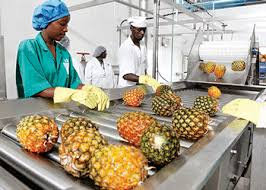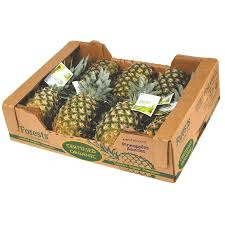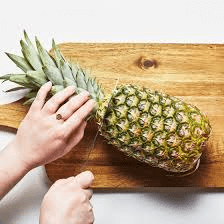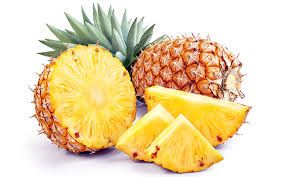Pineapple is a popular tropical fruit with a sweet, tangy taste and a rich source of vitamins, minerals, and fiber. It is widely consumed fresh, canned, or processed into juice. The demand for pineapple in international markets is strong, and many producers are interested in processing, packaging, and exporting this fruit. The process requires careful attention to detail to ensure that the fruit maintains its quality from harvest to market.
The first step in processing pineapple for export is the harvesting of the fruit. Pineapples are typically harvested when they are fully ripe, which is indicated by a golden yellow color on the skin and a sweet fragrance. Harvesting should be done carefully by hand to avoid damaging the fruit. Workers use sharp knives to cut the pineapple from the plant, leaving a small portion of the stalk attached. Once harvested, the pineapples are transported to the processing facility as quickly as possible to maintain freshness.
At the processing facility, the pineapples are first cleaned to remove dirt, debris, and any pesticide residues. This is usually done by washing the fruit with clean water. After washing, the pineapples are inspected for quality. Any damaged, overripe, or underripe fruits are removed from the batch. The remaining pineapples are then sorted by size and weight to ensure uniformity, which is important for packaging and presentation in the market.
For pineapples intended for fresh export, the next step is trimming and packaging. Trimming involves removing the crown (the leafy top of the pineapple) and, in some cases, a small portion of the base. Some markets prefer pineapples with the crown intact, while others require it to be removed. After trimming, the pineapples are graded based on size, weight, and appearance. They are then packed in strong, ventilated cartons that protect the fruit during transportation. Each carton is labeled with essential information, such as the country of origin, grade, weight, and any certifications.
In the case of canned pineapple, the fruit undergoes further processing. The pineapples are peeled, cored, and sliced or cut into chunks. The fruit pieces are then packed into cans with either syrup or juice, depending on the product specification. The cans are sealed and then heat-processed to kill any microorganisms and extend the shelf life of the product. Once cooled, the cans are labeled, packed into cartons, and prepared for export.
Exporting pineapple juice follows a similar process. The pineapples are peeled, cored, and crushed to extract the juice. The juice is then filtered, pasteurized, and sometimes concentrated to reduce volume for transportation. The juice is packed in sterilized containers, such as glass bottles, cans, or aseptic cartons, depending on the market requirements. These containers are then labeled, packed into boxes, and prepared for export.
Exporting pineapples requires compliance with international trade regulations and quality standards. Exporters must ensure that the pineapples meet the phytosanitary requirements of the importing country, which may include inspections for pests and diseases. It is also essential to obtain the necessary certifications, such as Global GAP (Good Agricultural Practices) or organic certification if the pineapples are grown organically. Proper documentation, including the certificate of origin, packing list, and phytosanitary certificate, must be prepared to accompany the shipment.
Transportation of pineapples is a critical aspect of the export process. Fresh pineapples are typically shipped by sea in refrigerated containers, known as reefers, to maintain the temperature and humidity levels that preserve the fruit’s freshness. The recommended temperature for shipping fresh pineapples is between 7 and 12 degrees Celsius. Pineapple juice and canned pineapples are usually shipped at ambient temperatures, but care must still be taken to avoid exposure to extreme temperatures that could affect the product quality.
Once the pineapples arrive at the destination port, they undergo customs clearance. This process involves verifying the documentation and inspecting the fruit or products to ensure they meet the importing country’s standards. If everything is in order, the shipment is cleared for entry and can be distributed to retailers, processors, or other buyers in the importing country.
The process of harvesting, processing, packaging, and exporting pineapples is complex and requires meticulous attention at each stage. From the careful selection and harvest of ripe fruit to the final packaging and transportation, each step is crucial to maintaining the quality and freshness of the pineapples.
By adhering to international standards and regulations, producers and exporters can ensure that their pineapples reach global markets in the best possible condition, satisfying consumer demand and contributing to the success of the pineapple industry.
How to Process Pineapple for Exportation

1. Harvesting: Start by harvesting pineapples when they are fully ripe. A ripe pineapple is golden-yellow and has a sweet aroma. Using a sharp knife, cut the fruit from the plant, ensuring to leave a small part of the crown attached.
2. Washing: Rinse the harvested pineapples thoroughly under running water to remove any dirt, pesticides, or residues. This step ensures that the fruit is clean before it undergoes further processing.
3. Peeling: After washing, peel the pineapples to remove the tough outer skin. This can be done manually with a knife or using a mechanical peeler if processing large quantities. Make sure to remove all the eyes (brown spots) from the fruit.
4. Cutting: Slice the peeled pineapples into uniform pieces. The size and shape of the pieces can vary based on your target market and the intended use of the pineapple. Consistent cutting helps in maintaining quality and appearance.
5. Core Removal: Remove the hard core from each pineapple piece. This step is crucial for ensuring that the final product is tender and suitable for consumption.
6. Blanching: Blanch the pineapple pieces in boiling water for a few minutes. This process helps in preserving color, texture, and flavor while also reducing microbial load. After blanching, cool the pineapple quickly in ice water.
7. Drying: Dry the blanched pineapple pieces to reduce moisture content, which helps in prolonging shelf life. This can be done using a dehydrator or through air-drying methods. Ensure the pineapple pieces are evenly dried.
8. Packaging: Once dried, package the pineapple pieces in moisture-proof and airtight packaging to maintain freshness. Use food-grade materials that are approved for export.
9. Quality Control: Conduct a thorough quality check to ensure that the processed pineapples meet international standards. This includes checking for consistency in size, color, and moisture content.
10. Documentation: Prepare all necessary export documentation, including quality certificates, phytosanitary certificates, and export permits. Proper documentation is essential for smooth customs clearance and compliance with international regulations.
Read Also: Hog Cholera (classical swine fever): Description, Damages Caused, Control and Preventive Measures
How to Package Pineapple for Exportation

1. Selecting Packaging Material: Choose packaging materials that are durable, moisture-resistant, and suitable for preserving the quality of pineapple. Common options include vacuum-sealed bags, plastic containers, or cardboard boxes with liners.
2. Vacuum Sealing: For dried pineapples, vacuum sealing is highly effective. It removes air from the packaging, preventing moisture and extending shelf life. Ensure that the vacuum-sealed bags are strong and not prone to tearing.
3. Labeling: Clearly label each package with essential information such as the product name, processing date, expiry date, and any relevant certifications. Proper labeling helps in identifying the product and complying with export regulations.
4. Packing: Place the packaged pineapples into larger cartons or pallets for bulk shipping. Ensure that the cartons are sturdy and capable of withstanding the rigors of transportation. Fill any empty spaces with cushioning materials to prevent movement.
5. Sealing and Storing: Seal all cartons securely and store them in a clean, dry, and cool environment. This helps in maintaining the quality of the pineapple during storage and transport.
6. Handling: Handle the packages with care to avoid damage. Use forklifts or other appropriate equipment to move the cartons, and avoid stacking them excessively high to prevent crushing.
7. Inspection: Before shipping, conduct a final inspection of the packages to ensure that they are properly sealed, labeled, and in good condition. This step is crucial to avoid any issues during export.
8. Documentation: Include all necessary export documents inside the package or with the shipment. This may include invoices, packing lists, and certificates of origin. Proper documentation facilitates smooth customs clearance.
9. Tracking: Implement a tracking system to monitor the movement of the packages from the warehouse to the destination. This helps in managing logistics and ensuring timely delivery.
10. Compliance: Ensure that the packaging meets the regulatory requirements of the destination country. Adhere to any specific packaging standards or guidelines that may be required for export.
How to Export Pineapple for Profits
1. Market Research: Conduct thorough market research to identify target markets and understand demand trends for pineapples. Analyze market prices, consumer preferences, and potential competitors.
2. Establish Export Channels: Build relationships with reliable export partners, including freight forwarders, shipping agents, and distributors. Having a strong network helps in streamlining the export process and reaching potential buyers.
3. Quality Assurance: Maintain high quality standards for your pineapples to meet international expectations. Regularly test your products for quality and adhere to global food safety standards.
4. Pricing Strategy: Set a competitive pricing strategy based on your market research and production costs. Consider factors such as shipping costs, tariffs, and exchange rates when determining your pricing.
5. Compliance with Regulations: Ensure compliance with export regulations and standards of the destination country. This includes obtaining necessary permits, certifications, and adhering to phytosanitary requirements.
6. Marketing and Promotion: Develop marketing materials and strategies to promote your pineapples in the target markets. Use online platforms, trade shows, and industry events to showcase your products and attract buyers.
7. Logistics Management: Plan and manage logistics efficiently to ensure timely delivery of your pineapples. Coordinate with shipping companies to arrange transportation and monitor the shipment throughout its journey.
8. Documentation Management: Prepare and manage all export documentation accurately. This includes commercial invoices, packing lists, certificates of origin, and any other required paperwork.
9. Customer Service: Provide excellent customer service to build strong relationships with buyers. Address any queries or issues promptly and maintain open communication to foster trust and satisfaction.
10. Monitor and Adapt: Continuously monitor market trends, customer feedback, and your export performance. Be prepared to adapt your strategies based on changing market conditions and opportunities for growth.
Read Also: Hog Cholera (classical swine fever): Description, Damages Caused, Control and Preventive Measures
Frequently Asked Questions (FAQ’s) About Pineapple

1. What is the best time to harvest pineapples?
Pineapples should be harvested when they are fully ripe, indicated by a golden-yellow color and a sweet aroma. Harvesting at the right time ensures the best flavor and quality.
2. How can I ensure the quality of exported pineapples?
Ensure quality by selecting ripe and healthy pineapples, following proper processing steps, and conducting quality checks throughout the process. Adhere to international standards and certifications.
3. What are the main export markets for pineapples?
Major export markets for pineapples include the United States, the European Union, and Asia. Research specific countries within these regions for the best opportunities.
4. How should pineapples be stored before export?
Store pineapples in a cool, dry place to maintain their quality. Proper storage conditions help prevent spoilage and preserve freshness until export.
5. What packaging materials are best for pineapples?
Use durable, moisture-resistant packaging materials such as vacuum-sealed bags or plastic containers. Ensure that the packaging protects the pineapples from damage during transport.
6. How long can pineapples be stored before export?
Fresh pineapples should be exported within a few days of harvest to ensure optimal freshness. Dried or processed pineapples can be stored for longer periods, depending on storage conditions.
7. What certifications are needed for exporting pineapples?
Certifications such as GlobalGAP, Organic, or Fairtrade can enhance your product’s appeal in international markets. Ensure you have the necessary phytosanitary certificates and export permits.
8. How do I handle pineapples during processing?
Handle pineapples with care to avoid bruising and damage. Use clean, sanitized equipment and follow hygiene practices to maintain quality throughout processing.
9. What are the common challenges in pineapple exportation?
Common challenges include managing quality control, adhering to international regulations, and dealing with logistical issues. Address these challenges through careful planning and coordination.
10. How can I improve profitability in pineapple exportation?
Improve profitability by optimizing production processes, reducing costs, targeting high-demand markets, and establishing strong relationships with buyers. Continuous market research and quality management are key to success.
Read Also: How To Fix a Garbage Disposal Jam

